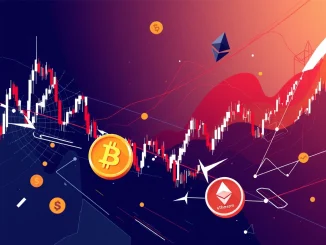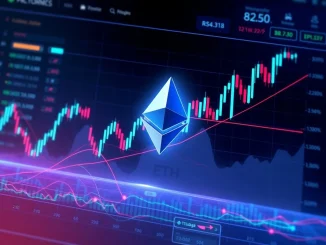
Prepare to dive into a pivotal moment for the world’s leading smart contract platform. Vitalik Buterin, co-founder of Ethereum, recently dropped a significant update on X, revealing that a remarkable nearly 50% of all staked ETH is now signaling support for an increase in the layer-1 (L1) gas limit. This isn’t just a theoretical discussion; the increase has already begun, with the current limit reaching 37.3 million. This development holds immense implications for the future of transaction costs, network speed, and overall Ethereum gas limit dynamics.
Understanding the Ethereum Gas Limit: What’s Changing?
For those new to the intricacies of blockchain, ‘gas’ on Ethereum is the unit of measure for the computational effort required to execute operations or transactions. The ‘gas limit’ is the maximum amount of gas a user is willing to spend on a transaction, or, in a broader sense, the maximum amount of gas that can be included in a single block. A higher block gas limit means more transactions can be processed within each block, directly impacting the network capacity.
Vitalik Buterin’s announcement confirms a significant shift. Previously, the gas limit hovered around 30 million. The recent movement to 37.3 million and the expressed support for 45 million indicates a collective desire to expand Ethereum’s throughput. This isn’t a unilateral decision; it’s a reflection of the network’s decentralized governance at play, with validators signaling their preference.
Vitalik Buterin’s Insights: A Glimpse into Ethereum’s Direction
When Vitalik Buterin speaks, the crypto world listens. His public statements often provide crucial insights into Ethereum’s developmental roadmap and philosophical underpinnings. His recent post on X wasn’t just an observation; it was a confirmation of a major operational shift gaining traction within the network. His advocacy for a higher gas limit aligns with Ethereum’s long-term vision of becoming a global, scalable settlement layer.
This move highlights a pragmatic approach to scalability. While Layer 2 solutions (like rollups) are crucial for off-chain processing, enhancing the Layer 1’s base capacity remains important for certain types of transactions and for ensuring the overall health and decentralization of the network. Vitalik’s involvement underscores the careful balance being struck between immediate improvements and long-term architectural changes.
The Power of ETH Stakers: Driving Network Evolution
The fact that nearly 50% of ETH stakers are backing this gas limit hike is a testament to the decentralized nature of Ethereum’s governance. Stakers, who secure the network by locking up their ETH, play a direct role in its evolution. By running validator nodes, they have the technical ability to vote on parameters like the gas limit. This collective action demonstrates a strong community consensus on increasing the network’s fundamental throughput.
For individual stakers and node operators, supporting a higher gas limit means contributing to a more efficient and accessible network. While there are considerations regarding increased hardware requirements for nodes to process larger blocks, the broad support suggests the perceived benefits outweigh these challenges for a significant portion of the staking community. This collective decision-making process is a cornerstone of Ethereum’s resilience and adaptability.
Boosting Network Capacity: The Scalability Imperative
The push to raise the network capacity of Ethereum’s Layer 1 is a direct response to the ever-growing demand for block space. As decentralized finance (DeFi), NFTs, and other dApps proliferate, the network can become congested, leading to high gas fees and slower transaction times. Increasing the gas limit allows more transactions to fit into each block, potentially alleviating some of this pressure.
Here’s how a higher gas limit contributes to network efficiency:
- Lower Transaction Costs: When more transactions can be processed per block, the competition for block space might decrease, leading to a reduction in average gas fees during periods of high demand.
- Faster Confirmations: With more room in each block, transactions are less likely to be stuck in the mempool, potentially leading to quicker confirmation times.
- Enhanced Throughput: The network can simply handle a greater volume of operations, supporting a wider range of applications and user activity.
It’s important to note that while this is a significant step, it’s part of a broader, multi-faceted strategy for blockchain scalability. Ethereum’s roadmap includes major upgrades like sharding and continued development of Layer 2 solutions, which will work in tandem with an optimized Layer 1 to achieve truly global scale.
The Road Ahead: Sustaining Blockchain Scalability
The gas limit increase is a tangible example of Ethereum’s continuous evolution towards greater blockchain scalability. It reflects the network’s ability to adapt and respond to the needs of its growing user base and developer community. While this adjustment offers immediate benefits, the journey towards a fully scalable and decentralized future is ongoing.
The successful implementation and community support for this gas limit hike set a positive precedent for future network adjustments. It underscores the importance of decentralized governance and the active participation of stakers in shaping Ethereum’s destiny. As the ecosystem matures, such collaborative efforts will be crucial in maintaining Ethereum’s position as a leading force in the blockchain space.
In conclusion, Vitalik Buterin’s confirmation of widespread staker support for a higher Ethereum gas limit marks a significant milestone. It signifies a collective commitment to enhancing the network’s immediate capacity, potentially leading to more efficient transactions and a smoother user experience. This development, driven by the decentralized power of ETH stakers, is a vital step in Ethereum’s ongoing quest for ultimate blockchain scalability and a robust network capacity, guided by the insights of figures like Vitalik Buterin.
Frequently Asked Questions (FAQs)
1. What is the Ethereum gas limit and why is it important?
The Ethereum gas limit is the maximum amount of computational effort (measured in ‘gas’) that can be included in a single block on the Ethereum blockchain. It’s crucial because it directly determines how many transactions or operations can be processed within each block, thus influencing network throughput and transaction fees.
2. Why is Vitalik Buterin’s announcement about the gas limit significant?
Vitalik Buterin’s announcement is significant because he confirmed that nearly 50% of staked ETH supports raising the gas limit to 45 million. As a co-founder and prominent voice, his statement validates a major network-wide consensus to enhance Ethereum’s capacity, signaling a concrete step towards improved scalability.
3. How does increasing the gas limit affect transaction fees and speeds?
A higher gas limit allows more transactions to be processed per block. This can lead to a decrease in average transaction fees (gas prices) during periods of high network demand, as there’s more available space. It can also result in faster transaction confirmation times because transactions are less likely to be delayed due to block congestion.
4. Who decides on the Ethereum gas limit increase?
The Ethereum gas limit is not set by a single entity. It’s determined by the validators (formerly miners) who produce blocks. They signal their preferred gas limit, and the network converges on an average. Vitalik’s statement indicates a strong consensus among the ETH stakers (validators) to support this increase.
5. Is increasing the gas limit a complete solution for Ethereum’s scalability?
No, increasing the gas limit is one part of Ethereum’s broader blockchain scalability strategy. While it immediately boosts Layer 1 network capacity, it doesn’t solve all scalability challenges. Other solutions like Layer 2 rollups (e.g., Optimism, Arbitrum) and future upgrades like sharding are essential for achieving truly massive scale.
6. Are there any risks associated with a higher gas limit?
While beneficial for throughput, a significantly higher gas limit can increase the computational and storage requirements for running an Ethereum node. This might make it more challenging for individuals to run full nodes, potentially impacting decentralization. However, the current proposed increase is generally seen as manageable and a net positive for the network’s health.



